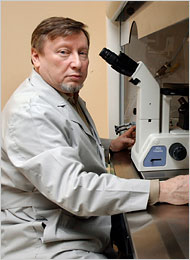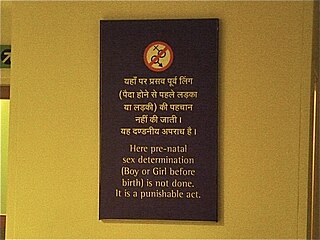
Sex-selective abortion is the practice of terminating a pregnancy based upon the predicted sex of the infant. The selective abortion of female fetuses is most common where male children are valued over female children, especially in parts of East Asia and South Asia, as well as in the Caucasus, Western Balkans, and to a lesser extent North America. Based on the third National Family and Health Survey, results showed that if both partners, mother and father, or just the father, preferred male children, sex-selective abortion was more common. In cases where only the mother prefers sons, this is likely to result in sex-selective neglect in which the child is not likely to survive past infancy.

In vitro fertilisation (IVF) is a process of fertilisation where an egg is combined with sperm in vitro. The process involves monitoring and stimulating a woman's ovulatory process, removing an ovum or ova from their ovaries and letting a man's sperm fertilise them in a culture medium in a laboratory. After the fertilised egg (zygote) undergoes embryo culture for 2–6 days, it is transferred by catheter into the uterus, with the intention of establishing a successful pregnancy.
Numerous religious traditions have taken a stance on abortion but few are absolute. These stances span a broad spectrum, based on numerous teachings, deities, or religious print, and some of those views are highlighted below.

Amniocentesis is a medical procedure used primarily in the prenatal diagnosis of genetic conditions. It has other uses such as in the assessment of infection and fetal lung maturity. Prenatal diagnostic testing, which includes amniocentesis, is necessary to conclusively diagnose the majority of genetic disorders, with amniocentesis being the gold-standard procedure after 15 weeks' gestation.

Preimplantation genetic diagnosis is the genetic profiling of embryos prior to implantation, and sometimes even of oocytes prior to fertilization. PGD is considered in a similar fashion to prenatal diagnosis. When used to screen for a specific genetic disease, its main advantage is that it avoids selective abortion, as the method makes it highly likely that the baby will be free of the disease under consideration. PGD thus is an adjunct to assisted reproductive technology, and requires in vitro fertilization (IVF) to obtain oocytes or embryos for evaluation. Embryos are generally obtained through blastomere or blastocyst biopsy. The latter technique has proved to be less deleterious for the embryo, therefore it is advisable to perform the biopsy around day 5 or 6 of development.

Prenatal testing is a tool that can be used to detect some birth defects at various stages prior to birth. Prenatal testing consists of prenatal screening and prenatal diagnosis, which are aspects of prenatal care that focus on detecting problems with the pregnancy as early as possible. These may be anatomic and physiologic problems with the health of the zygote, embryo, or fetus, either before gestation even starts or as early in gestation as practicable. Screening can detect problems such as neural tube defects, chromosome abnormalities, and gene mutations that would lead to genetic disorders and birth defects, such as spina bifida, cleft palate, Down syndrome, trisomy 18, Tay–Sachs disease, sickle cell anemia, thalassemia, cystic fibrosis, muscular dystrophy, and fragile X syndrome. Some tests are designed to discover problems which primarily affect the health of the mother, such as PAPP-A to detect pre-eclampsia or glucose tolerance tests to diagnose gestational diabetes. Screening can also detect anatomical defects such as hydrocephalus, anencephaly, heart defects, and amniotic band syndrome.
Sex selection is the attempt to control the sex of the offspring to achieve a desired sex. It can be accomplished in several ways, both pre- and post-implantation of an embryo, as well as at childbirth. It has been marketed under the title family balancing.

Baby Gender Mentor is the trade name of a controversial blood test designed for prenatal sex discernment. The test was manufactured by Acu-Gen Biolab, Inc., a biotech company in Lowell, Massachusetts, United States. The test made a media debut on 17 June 2005 on The Today Show and it was featured in Newsweek in October 2005. About 4,500 people had purchased the test by March 2006.
The genetics and abortion issue is an extension of the abortion debate and the disability rights movement. Since the advent of forms of prenatal diagnosis, such as amniocentesis and ultrasound, it has become possible to detect the presence of congenital disorders in the fetus before birth. Specifically, disability-selective abortion is the abortion of fetuses that are found to have non-fatal mental or physical defects detected through prenatal testing. Many prenatal tests are now considered routine, such as testing for Down syndrome. Women who are discovered to be carrying fetuses with disabilities are often faced with the decision of whether to abort or to prepare to parent a child with disabilities.
Abortion has been legal in India under various circumstances with the introduction of the Medical Termination of Pregnancy (MTP) Act, 1971. The Medical Termination of Pregnancy Regulations, 2003 were issued under the Act to enable women to access safe and legal abortion services.

Yury Verlinsky was a Russian-American medical researcher specializing in embryonic and cellular genetics. He is best known as a pioneer in prenatal diagnosis for detecting genetic and chromosomal disorders six weeks earlier than standard amniocentesis. The founding father of pre-implantation genetic diagnosis (PGD) and embryo analysis prior to in-vitro fertilization (IVF), Verlinsky used his polar body biopsy technique to detect potential birth defects in offspring. It is now accepted worldwide as the standard for the most efficient and effective means of analyzing the chromosomal status of an embryo.
Abortion in China is legal at all stages of pregnancy and generally accessible nationwide. Abortions are available to most women through China's family planning program, public hospitals, private hospitals, and clinics nationwide. China was one of the first developing countries to permit abortion when the pregnant woman's health was at risk and make it easily accessible under these circumstances in the 1950s. Following the Chinese Communist Revolution and the proclamation of the People's Republic of China in 1949, the country has periodically switched between more restrictive abortion policies to more liberal abortion policies and reversals. Abortion regulations may vary depending on the rules of the province. In an effort to curb sex-selective abortion, Jiangxi and Guizhou restrict non-medically necessary abortions after 14 weeks of pregnancy, while throughout most of China elective abortions are legal after 14 weeks. Although sex-selective abortions are illegal nationwide, they were previously commonplace, leading to a sex-ratio imbalance in China which still exists.
Prenatal sex discernment is the prenatal testing for discerning the sex of a fetus before birth.
Foeticide, or feticide, is the act of killing a fetus, or causing a miscarriage. Definitions differ between legal and medical applications, whereas in law, feticide frequently refers to a criminal offense, in medicine the term generally refers to a part of an abortion procedure in which a provider intentionally induces fetal demise to avoid the chance of an unintended live birth, or as a standalone procedure in the case of selective reduction.
Jatinder GH Hospital is a modern 50 bed hospital situated in Pakowal Road, Ludhiana, Punjab, India.
Female foeticide in India is the abortion of a female foetus outside of legal methods. A research by Pew Research Center based on Union government data indicates foeticide of at least 9 million females in the years 2000–2019. The research found that 86.7% of these foeticides were by Hindus, followed by Sikhs with 4.9%, and Muslims with 6.6%. The research also indicated an overall decline in preference for sons in the time period.
Female infanticide in India has a history spanning centuries. Poverty, the dowry system, births to unmarried women, deformed infants, famine, lack of support services, and maternal illnesses such as postpartum depression are among the causes that have been proposed to explain the phenomenon of female infanticide in India.

Intersex people are born with natural variations in physical and sex characteristics including those of the chromosomes, gonads, sex hormones, or genitals that, according to the UN Office of the High Commissioner for Human Rights, "do not fit the typical definitions for male or female bodies". Such variations may involve genital ambiguity, and combinations of chromosomal genotype and sexual phenotype other than XY-male and XX-female. Preimplantation genetic diagnosis allows the elimination of embryos and fetuses with intersex traits and thus has an impact on discrimination against intersex people.
Sex-selective abortion is the act of aborting a child due to its predicted sex. This practice gained popularity in the mid-1980s to early 1990s in South Korea, where selective female abortions were commonplace as male children were preferred. As a result, South Koreans aborted a much higher number of female fetuses than male ones in the 1980s and early 1990s. Historically, much of Korea's values and traditions were based on Confucianism, which dictates a patriarchal system, thus motivating the preference for sons over daughters. Additionally, even though the abortion ban existed, the combination of son preference and availability of sex-selective technology led to an increasing number of sex-selective abortions and boys born. As a result, South Korea experienced drastically high sex ratios around mid-1980s to early 1990s. However, in recent years, with the changes in family policies and modernization, attitudes towards son preference have changed, normalizing the sex ratio and lowering the number of sex-selective abortions. Additionally, during the entire 20th century South Korean women benefitted greatly from gender inequality declining at one of the fastest rates worldwide. However, there has been no explicit data collected on the number of induced sex selective abortions performed due to the abortion ban and controversy surrounding the topic. Therefore, scholars have been continuously analyzing and generating connections among sex-selection, abortion policies, gender discrimination, and other cultural factors.
On 14 June 2016 Anu Bansal from Bulandshahr, India, received 80% burns to her body and died at Safdarjung Hospital, New Delhi, a few days later. In July 2022, her husband, Manoj Bansal, was found guilty of killing her for "not giving birth to a son". He received life imprisonment and a fine of Rs 20,000.









